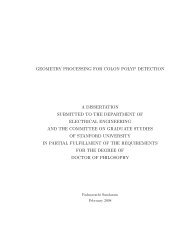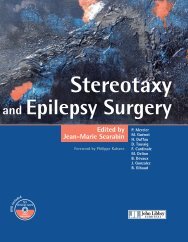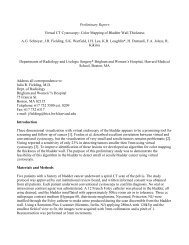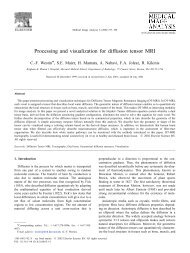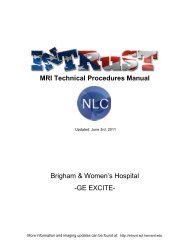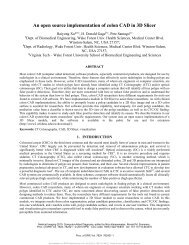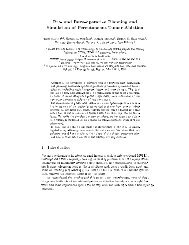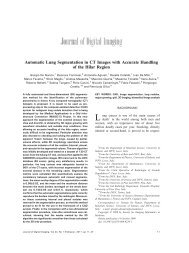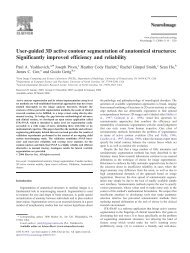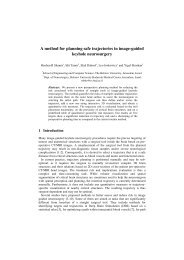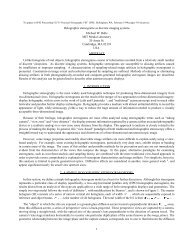Optic Radiation Fiber Tractography in Glioma Patients ... - 3D Slicer
Optic Radiation Fiber Tractography in Glioma Patients ... - 3D Slicer
Optic Radiation Fiber Tractography in Glioma Patients ... - 3D Slicer
Create successful ePaper yourself
Turn your PDF publications into a flip-book with our unique Google optimized e-Paper software.
<strong>Optic</strong> <strong>Radiation</strong> <strong>Tractography</strong> with DTI vs. HARDIalgorithms have already been implemented and <strong>in</strong>vestigated so far[7,8,9]. However, due to the restricted 2 nd order tensor model,multiple fiber populations with<strong>in</strong> a voxel cannot be resolvedadequately. This causes complications to resolve cross<strong>in</strong>g-, kiss<strong>in</strong>g-,diverg<strong>in</strong>g or highly curved fibers. Another problem appear<strong>in</strong>g withDTI-based fiber tractography is the resolution of fibers <strong>in</strong> areas ofdisturbed diffusion, for example due to tumor or peritumoraledema [10,11,12].To overcome these drawbacks, alternative diffusion imag<strong>in</strong>gand reconstruction schemes denoted as High Angular ResolutionDiffusion Imag<strong>in</strong>g (HARDI) [13] have become <strong>in</strong>creas<strong>in</strong>glyrelevant. A three-dimensional orientation distribution function isherewith <strong>in</strong>terpolated as a steady function on the sphere, forexample by spherical harmonics. However, the cl<strong>in</strong>ical use ofHARDI is limited due to larger number of diffusion-encod<strong>in</strong>ggradients (rang<strong>in</strong>g from 60 to 100), result<strong>in</strong>g <strong>in</strong> long acquisitiontimes [14,15,16]. A solution for this restriction is a sparserepresentation of signals, which is provided for example by theuse of spherical ridgelets, as proposed by Michailovich et al.[17,18,19].Us<strong>in</strong>g this protocol, HARDI data can be represented us<strong>in</strong>g arelatively small number of diffusion-encod<strong>in</strong>g gradients, thusenhanc<strong>in</strong>g the feasibility of HARDI-based fiber tractography <strong>in</strong>the cl<strong>in</strong>ical practice. This is implied <strong>in</strong> compressed sens<strong>in</strong>gtechniques (CS) [17,20,21,22].To <strong>in</strong>vestigate the feasibility of HARDI+CS for the reconstructionof the optic radiation (OR) <strong>in</strong> proximity of gliomas <strong>in</strong> thetemporal lobe with associated disturbed diffusion properties, weperformed fiber tractography based on DTI and HARDI+CS foreight patients. To our knowledge, this is the first cl<strong>in</strong>icalapplication and comparison of DTI-, and HARDI+CS-basedfiber tractography for the OR, show<strong>in</strong>g the potential of HARDIwith respect to challeng<strong>in</strong>g <strong>in</strong>tra-voxel fiber distributions.Materials and Methods<strong>Patients</strong>The study was conducted as a prospective case series withretrospective data analysis after approval by the ethics commissionof the Philipps-University of Marburg, Germany. All patients gavetheir written <strong>in</strong>formed consent to participate <strong>in</strong> the study. The<strong>in</strong>formed consent form was also approved by the ethicscommission, Philipps-University of Marburg, Germany. Eightpatients with gliomas, all located <strong>in</strong> the left temporal lobe, were<strong>in</strong>cluded <strong>in</strong> our study. Mean patient age was 54.8 years. Threefemale patients and five male patients participated. To comparetumor size <strong>in</strong>clud<strong>in</strong>g peritumoral edema and their <strong>in</strong>fluence on thefiber reconstruction, all tumors were manually segmented acrossall slices. In case the tumor showed contrast-enhancement, bothT1+gadol<strong>in</strong>ium-, and T2-weighted tumor outl<strong>in</strong>es were segmented.Otherwise, only T2-weighted tumor outl<strong>in</strong>es were segmented.Tumor volumes are given <strong>in</strong> [cm 3 ]. Furthermore the m<strong>in</strong>imumdistance from the tumor outl<strong>in</strong>es to the fiber object, based onHARDI+CS was calculated <strong>in</strong> [mm]. All tumors were located <strong>in</strong>close proximity to the reconstructed OR with less than 20 mm (seeTable 1).MRIMR images were acquired at a 3T MRI (Tim Trio, Siemens,Erlangen, Germany) preoperatively, <strong>in</strong>clud<strong>in</strong>g T1-weighted <strong>3D</strong>images (<strong>3D</strong>-Magnetization Prepared Rapid Gradient Echo(MPRAGE)): repetition time (TR) 1900 ms, echo time (TE)2.26 ms, field of view (FoV) 256 mm, matrix 2566256, slicethickness 1 mm, 176 slices, sagittal). The protocol for diffusionimag<strong>in</strong>g was TR 7800 ms, TE 90 ms, FoV 256 mm, matrix1286128, slice thickness 2 mm, numbers of excitation (NEX) = 1,b = 1000 s/mm 2 , 30 non-coll<strong>in</strong>ear diffusion-encod<strong>in</strong>g gradients,voxel size of 26262 mm 3 . This same diffusion images were thebase for DTI-based fiber tractography and HARDI+CS-basedfiber tractography. Acquisition of diffusion imag<strong>in</strong>g data took5 m<strong>in</strong>utes per patient.<strong>Fiber</strong> tractographyEvaluation was performed us<strong>in</strong>g the image analysis platformMedAlyVis (Medical Analysis and Visualization) [23] for both,DTI-based and advanced fiber tractography us<strong>in</strong>g HARDI signalsderived from sparsely sampled diffusion data (HARDI+CS). ForDTI-based fiber tractography, a tensor deflection approach withfractional anistotropy (FA) thresholds of 0.18–0.2 was applied. Fortractography based on HARDI+CS, a determ<strong>in</strong>istic multidirectionalorientation distribution function (ODF) track<strong>in</strong>g was applied[12] with the L-<strong>in</strong>dex [24] as anisotropy measure, set to 0.03(maximum angle: 90 degrees, maximum steps: 500, stepsize: 1).For both, DTI-, and HARDI+CS-based fiber reconstruction,the same manually segmented region around the lateral geniculatenucleus (LGN) was used as seed region. The visual cortex was thenused as <strong>in</strong>clude region, result<strong>in</strong>g <strong>in</strong> a fiber object pass<strong>in</strong>g throughthe LGN and term<strong>in</strong>at<strong>in</strong>g <strong>in</strong> the visual cortex (Brodman areas 17–19). These ROIs were determ<strong>in</strong>ed by experienced exam<strong>in</strong>ers (oversix years of expertise), one neurosurgeon and one neurologist.Results – Case SeriesCase 1A 74 year old male patient presented with a temporal tumorwith slight and diffuse contrast enhancement <strong>in</strong> T1-weighted MRI.T2-weighted MR-signal however revealed mass of approximately(app.) 35 cm 3 (Table 1).For both DTI and HARDI+CS-based fiber tractography, wefound a fiber bundle, reach<strong>in</strong>g from LGN to the visual cortex.However, DTI-based fibers were slender and diffusely orientated.HARDI+CS-based tractography, however displayed a more solidfiber bundle, represent<strong>in</strong>g the OR without significant loop<strong>in</strong>g ofMeyer’s loop (ML). Still, all three parts of the OR <strong>in</strong> relation to theventricular system are reproducible with both methods (Figure 1,row 1).Case 2A 65 year-old female patient <strong>in</strong>itially presented with aphasia.T1-weighted MRI scans showed a contrast enhanc<strong>in</strong>g tumor <strong>in</strong>the left temporal lobe of app. 11 cm 3 with central necrosis,however with a strong peritumoral edema (Table 1).In this case, on the basis of DTI no fiber bundle pass<strong>in</strong>g throughLGN and term<strong>in</strong>at<strong>in</strong>g <strong>in</strong> the visual cortex was reliably traced.Only one s<strong>in</strong>gle fiber was found, which can hardly be assigneddef<strong>in</strong>itely to one of the three parts of the OR. This is opposed toHARDI+CS-based fiber tractography, which displayed the ORwith its three bundles <strong>in</strong>clud<strong>in</strong>g the ML, form<strong>in</strong>g a pronouncedloop <strong>in</strong> anterolateral direction (Figure 1, row 2).Case 3HARDI+CS-based fiber tractography of this 41 year-old malepatient with a relatively small anaplastic astrocytoma (WHO III) <strong>in</strong>the left temporal lobe, displayed a fiber bundle from LGN to thecalcar<strong>in</strong>e sulcus. In this case, the ML does not loop significantly.However, tractography results also <strong>in</strong>clude some diffusely runn<strong>in</strong>gfibers, rather not belong<strong>in</strong>g to the OR (<strong>in</strong> anterior temporo-mesialdirection and direct<strong>in</strong>g to the corpus callosum). S<strong>in</strong>gle-ROI DTI-PLOS ONE | www.plosone.org 2 July 2013 | Volume 8 | Issue 7 | e70973



